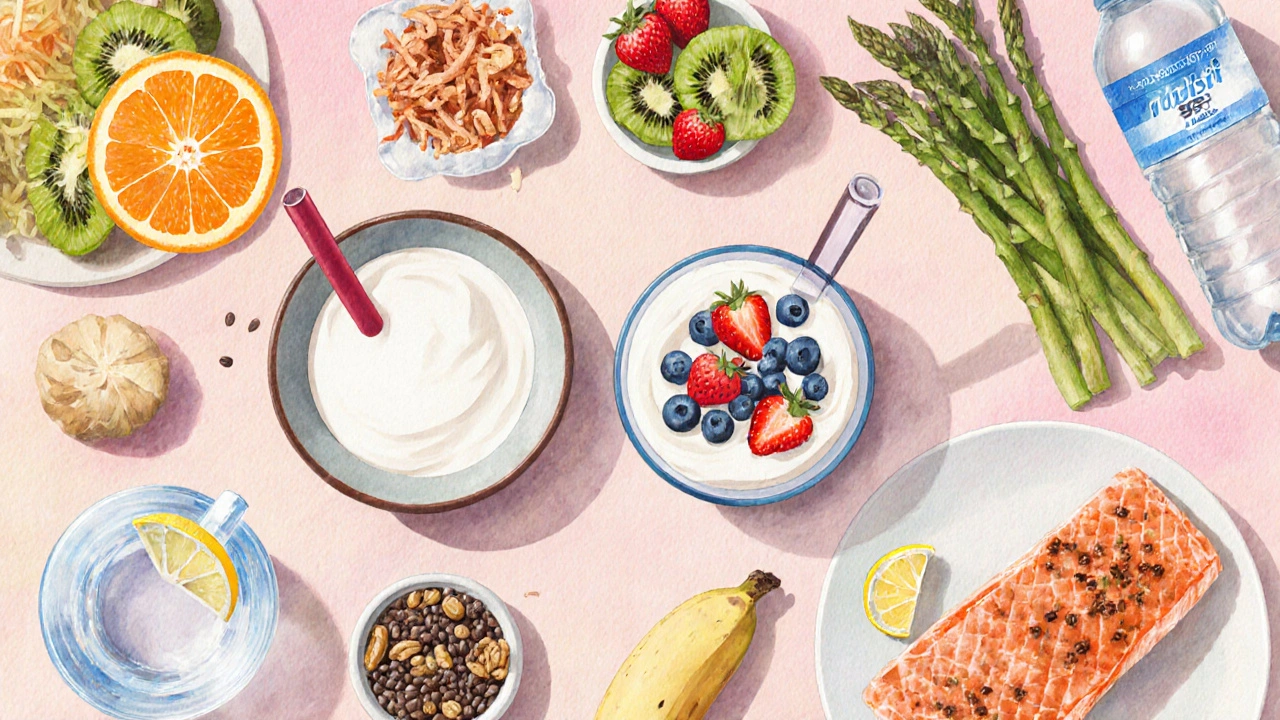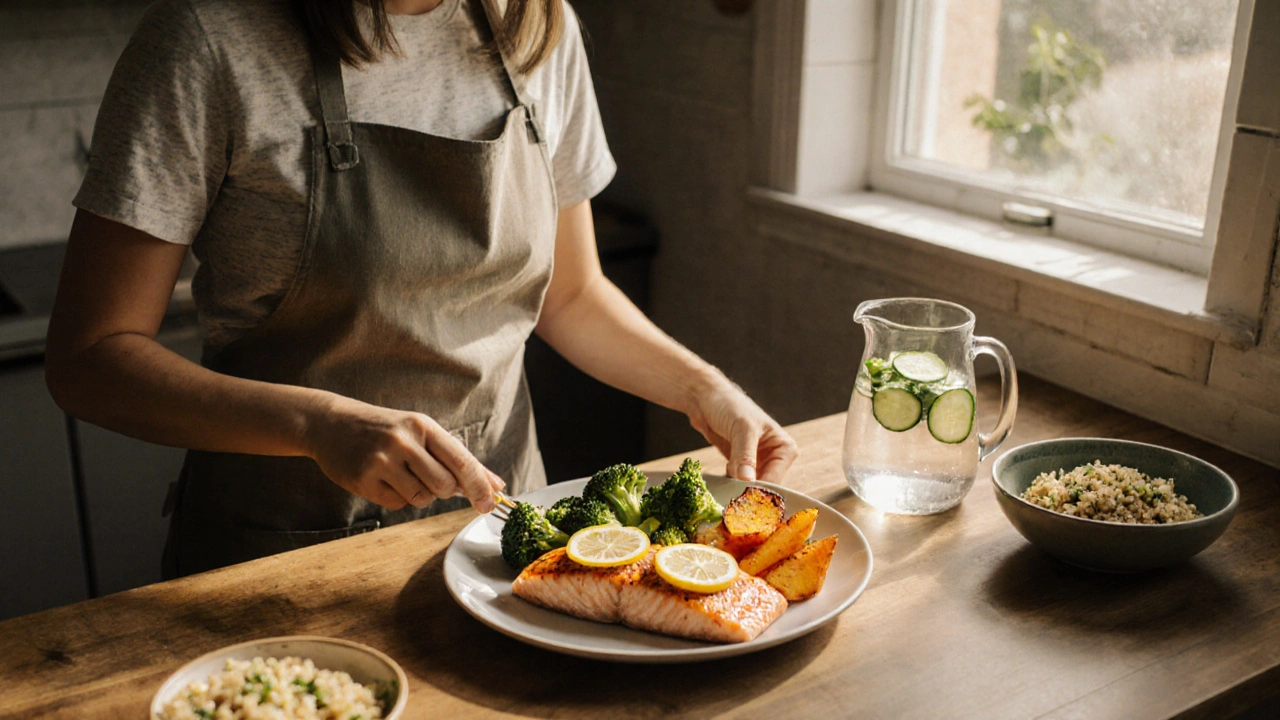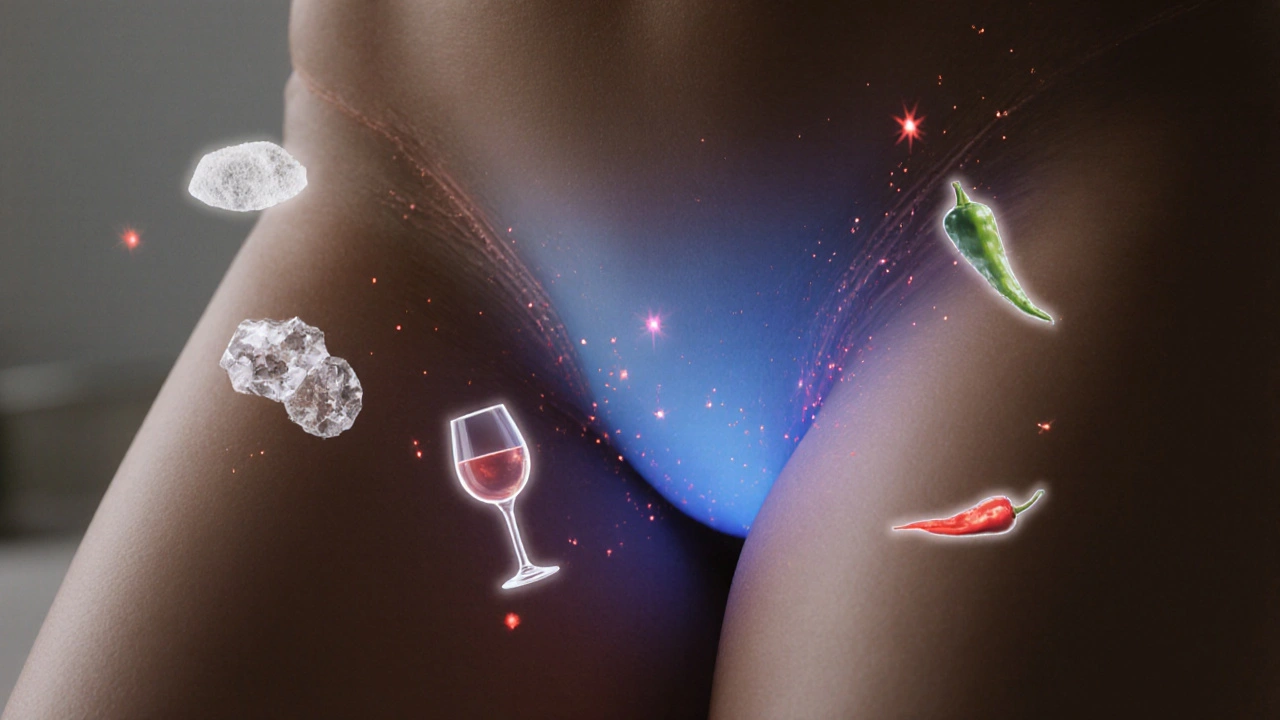Quick Takeaways
- Vaginal burning often stems from pH imbalance, infections, or dietary triggers.
- Probiotic‑rich foods, plenty of water, and low‑sugar choices support a healthy vaginal environment.
- Avoid excessive refined carbs, alcohol, and spicy items that can irritate the vaginal lining.
- Include vitamin‑C‑rich fruits, whole grains, and omega‑3 sources for anti‑inflammatory benefits.
- Seek medical advice if symptoms persist for more than a week or worsen.
If you're dealing with vaginal burning, your diet could be a game changer.
What Is Vaginal Burning?
Vaginal burning is a symptom described as a sharp, stinging sensation inside the vagina, often accompanied by itching, redness, or a raw feeling. It’s not a disease on its own, but a warning sign that something in the body’s environment is off‑balance. Common culprits include yeast infections, bacterial vaginosis, hormonal shifts, and irritation from chemicals or foods.
How Diet Influences Vaginal Health
Every part of the body is linked to what we eat, and the vaginal flora is especially sensitive to sugar and acidity. A balanced diet is a pattern of eating that supplies all essential nutrients while keeping excess sugar, unhealthy fats, and irritants to a minimum. When the diet is right, good bacteria (Lactobacilli) thrive, keeping the vaginal pH around 3.8-4.5, which discourages harmful microbes.
Conversely, a high‑sugar, low‑fiber diet can feed Candida yeast, leading to overgrowth and the dreaded burning feeling. Even foods that cause systemic inflammation-like processed meats and trans fats-can make the vaginal lining more sensitive.
Key Dietary Factors That Can Trigger Burning
- Refined sugars spike blood glucose and give yeast the fuel it needs to multiply.
- Alcohol can dehydrate tissues and change vaginal pH temporarily.
- Spicy foods may irritate mucous membranes, especially for those already prone to inflammation.
- Caffeinated drinks (coffee, energy drinks) act as mild diuretics, reducing hydration levels.
- Artificial sweeteners can alter gut microbiota, indirectly affecting vaginal flora.

Foods That Support a Healthy Vaginal Environment
Below are groups of foods that help maintain a low vaginal pH, boost good bacteria, and calm inflammation.
- Probiotic‑rich foods such as plain yogurt, kefir, sauerkraut, kimchi, and miso. These deliver live Lactobacillus strains directly.
- Prebiotic fibers found in garlic, onions, bananas, and asparagus. They feed the good bacteria already present.
- Vitamin C sources like oranges, strawberries, kiwi, and bell peppers. Vitamin C strengthens tissue integrity and helps keep the pH acidic.
- Omega‑3 fatty acids from fatty fish (salmon, mackerel), chia seeds, and walnuts reduce systemic inflammation.
- Hydrating fluids - plain water, herbal teas, and coconut water keep the vaginal tissues moisturized.
Beneficial vs. Harmful Foods - Quick Comparison
| Helpful | Potentially Harmful |
|---|---|
| Plain yogurt (live cultures) | Sweetened yogurts & desserts |
| Kefir smoothies | Energy drinks, high‑caffeine soda |
| Fermented veggies (sauerkraut, kimchi) | Pickles with added sugar |
| Whole‑grain bread, quinoa | White bread, pastries |
| Fresh berries, citrus | Fruit juices with added sugar |
| Salmon, walnuts | Fried meats, processed sausages |
Sample 7‑Day Balanced Meal Plan
Feel free to swap meals according to taste or availability, but keep the core principles: low added sugar, plenty of probiotics, and hydration.
- Day 1: Breakfast - Greek yogurt with berries and flaxseed; Lunch - Quinoa salad with chickpeas, cucumber, and lemon‑tahini dressing; Dinner - Baked salmon, steamed broccoli, and sweet potato.
- Day 2: Breakfast - Oatmeal topped with sliced kiwi and a drizzle of honey; Lunch - Whole‑grain wrap with turkey, sauerkraut, and avocado; Dinner - Stir‑fried tofu, bell peppers, and brown rice.
- Day 3: Breakfast - Smoothie with kefir, spinach, banana, and chia seeds; Lunch - Lentil soup with a side of mixed greens; Dinner - Grilled chicken, quinoa pilaf, and roasted carrots.
- Day 4: Breakfast - Scrambled eggs with tomatoes and mushrooms; Lunch - Miso soup with seaweed and edamame; Dinner - Baked cod, asparagus, and wild rice.
- Day 5: Breakfast - Cottage cheese with pineapple chunks; Lunch - Salad with mixed nuts, sliced apple, and vinaigrette; Dinner - Turkey meatballs, zucchini noodles, and marinara.
- Day 6: Breakfast - Whole‑grain toast with almond butter and sliced strawberries; Lunch - Chickpea and avocado mash on rye; Dinner - Veggie curry with coconut milk, served over basmati rice.
- Day 7: Breakfast - Probiotic kefir parfait with granola (no added sugar) and blueberries; Lunch - Grilled halloumi, mixed quinoa, and cucumber‑mint salad; Dinner - Shrimp sautéed with garlic, lemon, and spinach.
Throughout the week, aim for at least eight glasses of water. If you’re active, add an extra glass or two.

When to Seek Professional Help
Diet can do a lot, but it isn’t a substitute for medical care. Contact a healthcare provider if you notice any of the following:
- Burning persists for more than 7‑10 days despite dietary changes.
- Accompanying symptoms such as abnormal discharge, strong odor, or bleeding.
- Repeated episodes despite good hygiene and balanced meals.
- Recent antibiotic use (antibiotics can disrupt normal flora).
- Diabetes or other conditions that affect sugar regulation.
Doctors may run a vaginal swab, pH test, or recommend antifungal or antibacterial treatment based on the cause.
Common Myths About Vaginal Burning and Diet
- Myth: All spicy food causes burning.
Fact: Spices can trigger symptoms for some, but the real culprit is often an underlying pH imbalance. \n - Myth: You need to eliminate all carbs.
Fact: Complex carbs like whole grains provide fiber that supports prebiotic health. - Myth: Only women get yeast infections.
Fact: Men can also develop Candida overgrowth, though symptoms differ.
Frequently Asked Questions
Can drinking coffee make vaginal burning worse?
Coffee is a mild diuretic, which can reduce overall hydration. Dehydrated tissue may feel more irritated, so limiting caffeine to 1‑2 cups a day and drinking extra water can help.
Do probiotic supplements work as well as food sources?
Supplements can be effective, but they vary in strain quality and colony‑forming units (CFUs). Whole‑food sources provide additional nutrients and prebiotic fibers that support the bacteria, making them a more comprehensive option.
Is it safe to eat fruit during a yeast infection?
Fresh, low‑sugar fruits like berries, kiwi, and citrus are fine. Avoid fruit juices and dried fruit, which concentrate sugars and can feed Candida.
How much water should I drink each day?
Aim for at least 2liters (about eight glasses). If you exercise, are pregnant, or live in a hot climate, add an extra 0.5‑1liter.
Can hormonal birth control cause vaginal burning?
Some hormonal contraceptives can alter vaginal flora, leading to irritation or yeast overgrowth for certain individuals. If you notice a pattern, discuss alternative methods with your GP.
By tweaking what you eat, you give your body the tools it needs to keep the vaginal ecosystem balanced. Pair these changes with good hygiene and regular check‑ups, and you’ll likely see the burning fade away.


Thanks for the practical tips, I’ll give the probiotic yogurt a try.
The elucidation of the gut‑vaginal axis is indeed a subtle reminder that our culinary choices echo far beyond the palate. By embracing fermented staples such as kefir and kimchi, one cultivates a bastion of Lactobacilli, thereby fostering the acidic milieu that dissuades opportunistic yeasts. Moreover, eschewing refined sucrose is not merely a matter of caloric restraint but a strategic denial of substrate for Candida proliferation. I find that the inclusion of omega‑3‑laden marine fare imparts anti‑inflammatory benefits that reverberate through mucosal health. In sum, a thoughtfully curated alimentation is the quiet architect of comfort.
Good rundown on the food groups, keep it simple and stay consistent. Small changes add up over time.
Esteemed readers, the principles delineated herein transcend cultural boundaries, offering a universally applicable framework for maternal and feminine well‑being. By integrating probiotic-rich items alongside adequate hydration, one upholds the sanctity of the vaginal micro‑environment, a cornerstone of holistic health.
The flames of discomfort often kindle not from the spice alone, but from an inner disharmony-a discord between body and nourishment. To surrender to the allure of sugary indulgence is to invite the silent insurgent, Candida, to the banquet of our intimate realms. Let us therefore not merely diet, but orchestrate a symphony of flora, where each probiotic note harmonizes with the overture of vitamin‑rich fruits, and the crescendo of omega‑3s quenches the inferno of inflammation.
Ah yes, because the internet says “just cut carbs” and suddenly everyone’s a miracle‑cure guru. If only we could all survive on air and good vibes, the world would be a blissful void of burning, wouldn’t it?
😊 I hear you, Justyne-while the hype can be overwhelming, there’s solid science behind probiotics and hydration. Balance is the real champion here, not extreme fads.
In the grand tapestry of human health, the disciplines of nutrition and microbiology intertwine with profound elegance. One might contemplate the epistemic merits of a diet replete with live cultures, acknowledging that such choices resonate with the very principles of homeostasis espoused by the ancients.
Well said. A gentle reminder that consistency, more than occasional zeal, yields sustainable results.
Thank you for assembling such a comprehensive guide. The blend of scientific insight with actionable meal plans makes it easier for anyone to start the journey toward relief.
Your effort clearly shines through, Selena. Emphasizing water intake alongside nutrient‑dense foods creates a dual approach-hydration fortifies mucosal barriers, while pre‑ and probiotic sources nurture a resilient microbiome.
Let me expand on that a bit. First, water is the foundation of every cellular process, and staying well‑hydrated ensures that the vaginal epithelium remains supple and less prone to irritation. Second, when you consume excessive refined sugars, you effectively provide Candida with a feast, allowing it to proliferate unchecked. Third, the inclusion of fiber‑rich prebiotics-such as garlic, onions, and asparagus-not only feeds beneficial Lactobacilli but also promotes regular bowel movements, which helps keep the entire gut‑vaginal axis in balance. Fourth, probiotic foods like plain yogurt or kefir deliver live cultures directly, seeding the vaginal environment with the strains that maintain an acidic pH. Fifth, vitamin‑C rich fruits act as antioxidants, supporting tissue repair and bolstering the mucosal barrier against pathogens. Sixth, omega‑3 fatty acids found in salmon or walnuts have a systemic anti‑inflammatory effect, reducing the overall inflammatory load that can exacerbate burning sensations. Seventh, limiting alcohol and caffeine cuts down on diuretic effects, preserving moisture in your tissues. Eighth, the avoidance of artificial sweeteners prevents unwanted alterations in gut microbiota that can indirectly affect vaginal health. Ninth, a well‑planned meal schedule that spreads protein, healthy fats, and complex carbs throughout the day helps maintain stable blood glucose levels, denying yeast the spikes it craves. Tenth, regular moderate exercise improves circulation, delivering nutrients more efficiently to all tissues, including those of the pelvic region. Eleventh, adequate sleep supports immune function, which is essential for keeping opportunistic infections at bay. Twelfth, stress management techniques such as mindfulness or gentle yoga can lower cortisol, a hormone that, when elevated, can disrupt the vaginal microbiome. Thirteenth, consider a targeted probiotic supplement if dietary sources are insufficient, but choose one with clinically proven strains and a high CFU count. Fourteenth, always monitor your symptoms-if burning persists beyond a week despite these adjustments, it’s prudent to seek medical evaluation. Finally, remember that each individual’s response varies; what works wonderfully for one may need tweaking for another. Consistency, patience, and listening to your body’s signals are the true keys to lasting relief.